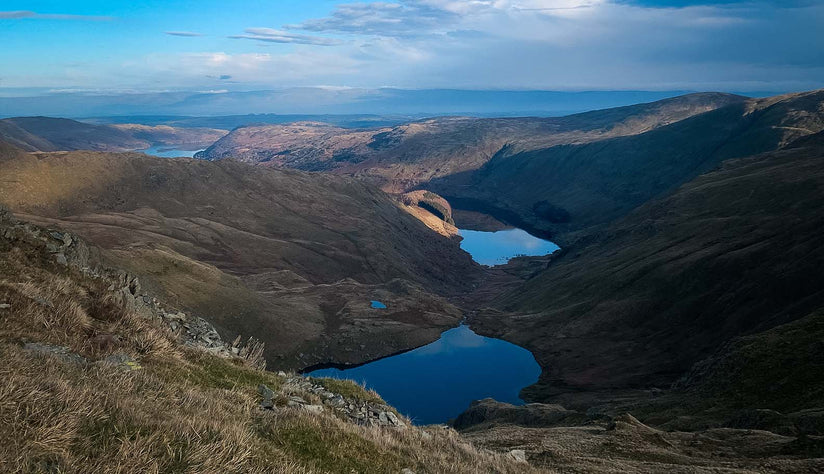You’ll never walk alone.
The 'Third Man Factor' is a phenomenon that is experienced at the edges of existence, those moments when mountaineers, sailors, and Polar explorers, have the vivid experience of another human being sharing their struggle. Here Dan Neilson investigates the phenomenon:

“Boss, I had a curious feeling on the march that there was another person with us.” Frank Worsley, captain of the Endurance, told Ernest Shackleton. Tom Crean, an Irish seaman, later admitted the same. After the Endurance became trapped in ice and destroyed, the crew escaped on a lifeboat, sailing 800 stormy miles to South Georgia. Here, Shackleton, Worsley and Crean embarked on an arduous walk to Stromness whaling station to find help. Shackleton wrote: “During that long and racking march of thirty-six hours over the unnamed mountains and glaciers of South Georgia, it seemed to me often that we were four, not three.”
Shackleton and his companions could be forgiven for hunger-struck hallucinations or fatigue-blinded phantoms, but what they felt back in 1914, has turned out to be a relatively common sensation.

If ‘The Third Man’ inspires images of Orson Wells running through Vienna’s sewers or the plinky zither sound of Anton Karas’s score, then you probably haven’t experienced what many people who have endured extreme scenarios have. The third man factor or syndrome is a phenomenon (in the most real sense of the word), that is used to describe the unshakable feeling that another person is with you, supporting you, empathising with you, helping you on your way.
Ann Bancroft, the first woman to reach the North Pole by foot and sledge, also experienced it on her Arctic expeditions. She told NPR: “It's just sort of when you're out in these white places for an extended period, you have a lot of sensory deprivation. So there's that element. And then there's also this element that some people would describe as spirits or a presence that appears when things are challenging, physically and emotionally. When you're really putting out. So the third man aura is sort of an appearance."

British explorer Frank Smythe, who came within 300 metres of Everest’s summit, actually took out some Kendal Mint Cake, broke it in half and offered it to the ‘third man’. Solo sailors, mountaineers, wreck survivors, fisherman and Polar explorers have all described similar experiences: that in times of peril, there is someone with them, not just a deity or an ancestor, but another human being, a physical presence. Survivors of the 9/11 attacks on the World Trade Centre have also reported similar sentiments.
Scientists in the past have posited that it could be the effects of hypothermia, hypoxia or perhaps low levels of glucose, but the most accepted explanation is that it is not physiological, but mostly psychological. There’s a disconnect between the body and its senses, as extreme stress and in cases of Polar explorers, sheer boredom can produce the effects, no doubt compounded by physical attributes.

The Third Man Factor has also been described as a Guardian Angel, but far from being wrapped in the exhausted or starved imaginations of those on the brink of death, it is firmly grounded in recognised psychology. It’s not too far removed from a child with an imaginary friend, someone they speak to when stressed. These are not of vengeful hallucinations, but friends who have your back.
Psychologists widely recognise the effect and have turned the same mechanism into a treatment. Chris Clarke, a consultant clinical psychologist and clinical lecturer at the University of Hull, told Montane: “In compassion-focused therapy, we often help people develop an inner image of a compassionate and protective figure; a person that someone can draw strength and resilience from. It relates to how the human brain naturally has a safety or soothing system involving hormone called oxytocin that when activated has a powerful influence in dealing with fear and distress.”

Another common element is that when help arrives or the stress is over, the third man disappears. Vanishing into the white air, Kendal mint cake in hand.
Inspired by Shackleton’s experiences, TS Eliot introduced the theme into his poem The Waste Land: “Who is the third who walks always beside you?/When I count, there are only you and I together/But when I look ahead up the white road/There is always another one walking beside you”.
Perhaps a sentiment we can all take comfort in.

- By Daniel Neilson












 “Boss, I had a curious feeling on the march that there was another person with us.” Frank Worsley, captain of the Endurance, told Ernest Shackleton. Tom Crean, an Irish seaman, later admitted the same. After the Endurance became trapped in ice and destroyed, the crew escaped on a lifeboat, sailing 800 stormy miles to South Georgia. Here, Shackleton, Worsley and Crean embarked on an arduous walk to Stromness whaling station to find help. Shackleton wrote: “During that long and racking march of thirty-six hours over the unnamed mountains and glaciers of South Georgia, it seemed to me often that we were four, not three.”
Shackleton and his companions could be forgiven for hunger-struck hallucinations or fatigue-blinded phantoms, but what they felt back in 1914, has turned out to be a relatively common sensation.
“Boss, I had a curious feeling on the march that there was another person with us.” Frank Worsley, captain of the Endurance, told Ernest Shackleton. Tom Crean, an Irish seaman, later admitted the same. After the Endurance became trapped in ice and destroyed, the crew escaped on a lifeboat, sailing 800 stormy miles to South Georgia. Here, Shackleton, Worsley and Crean embarked on an arduous walk to Stromness whaling station to find help. Shackleton wrote: “During that long and racking march of thirty-six hours over the unnamed mountains and glaciers of South Georgia, it seemed to me often that we were four, not three.”
Shackleton and his companions could be forgiven for hunger-struck hallucinations or fatigue-blinded phantoms, but what they felt back in 1914, has turned out to be a relatively common sensation.
 If ‘The Third Man’ inspires images of Orson Wells running through Vienna’s sewers or the plinky zither sound of Anton Karas’s score, then you probably haven’t experienced what many people who have endured extreme scenarios have. The third man factor or syndrome is a phenomenon (in the most real sense of the word), that is used to describe the unshakable feeling that another person is with you, supporting you, empathising with you, helping you on your way.
Ann Bancroft, the first woman to reach the North Pole by foot and sledge, also experienced it on her Arctic expeditions. She told NPR: “It's just sort of when you're out in these white places for an extended period, you have a lot of sensory deprivation. So there's that element. And then there's also this element that some people would describe as spirits or a presence that appears when things are challenging, physically and emotionally. When you're really putting out. So the third man aura is sort of an appearance."
If ‘The Third Man’ inspires images of Orson Wells running through Vienna’s sewers or the plinky zither sound of Anton Karas’s score, then you probably haven’t experienced what many people who have endured extreme scenarios have. The third man factor or syndrome is a phenomenon (in the most real sense of the word), that is used to describe the unshakable feeling that another person is with you, supporting you, empathising with you, helping you on your way.
Ann Bancroft, the first woman to reach the North Pole by foot and sledge, also experienced it on her Arctic expeditions. She told NPR: “It's just sort of when you're out in these white places for an extended period, you have a lot of sensory deprivation. So there's that element. And then there's also this element that some people would describe as spirits or a presence that appears when things are challenging, physically and emotionally. When you're really putting out. So the third man aura is sort of an appearance."
 British explorer Frank Smythe, who came within 300 metres of Everest’s summit, actually took out some Kendal Mint Cake, broke it in half and offered it to the ‘third man’. Solo sailors, mountaineers, wreck survivors, fisherman and Polar explorers have all described similar experiences: that in times of peril, there is someone with them, not just a deity or an ancestor, but another human being, a physical presence. Survivors of the 9/11 attacks on the World Trade Centre have also reported similar sentiments.
Scientists in the past have posited that it could be the effects of hypothermia, hypoxia or perhaps low levels of glucose, but the most accepted explanation is that it is not physiological, but mostly psychological. There’s a disconnect between the body and its senses, as extreme stress and in cases of Polar explorers, sheer boredom can produce the effects, no doubt compounded by physical attributes.
British explorer Frank Smythe, who came within 300 metres of Everest’s summit, actually took out some Kendal Mint Cake, broke it in half and offered it to the ‘third man’. Solo sailors, mountaineers, wreck survivors, fisherman and Polar explorers have all described similar experiences: that in times of peril, there is someone with them, not just a deity or an ancestor, but another human being, a physical presence. Survivors of the 9/11 attacks on the World Trade Centre have also reported similar sentiments.
Scientists in the past have posited that it could be the effects of hypothermia, hypoxia or perhaps low levels of glucose, but the most accepted explanation is that it is not physiological, but mostly psychological. There’s a disconnect between the body and its senses, as extreme stress and in cases of Polar explorers, sheer boredom can produce the effects, no doubt compounded by physical attributes.
 The Third Man Factor has also been described as a Guardian Angel, but far from being wrapped in the exhausted or starved imaginations of those on the brink of death, it is firmly grounded in recognised psychology. It’s not too far removed from a child with an imaginary friend, someone they speak to when stressed. These are not of vengeful hallucinations, but friends who have your back.
Psychologists widely recognise the effect and have turned the same mechanism into a treatment. Chris Clarke, a consultant clinical psychologist and clinical lecturer at the University of Hull, told Montane: “In compassion-focused therapy, we often help people develop an inner image of a compassionate and protective figure; a person that someone can draw strength and resilience from. It relates to how the human brain naturally has a safety or soothing system involving hormone called oxytocin that when activated has a powerful influence in dealing with fear and distress.”
The Third Man Factor has also been described as a Guardian Angel, but far from being wrapped in the exhausted or starved imaginations of those on the brink of death, it is firmly grounded in recognised psychology. It’s not too far removed from a child with an imaginary friend, someone they speak to when stressed. These are not of vengeful hallucinations, but friends who have your back.
Psychologists widely recognise the effect and have turned the same mechanism into a treatment. Chris Clarke, a consultant clinical psychologist and clinical lecturer at the University of Hull, told Montane: “In compassion-focused therapy, we often help people develop an inner image of a compassionate and protective figure; a person that someone can draw strength and resilience from. It relates to how the human brain naturally has a safety or soothing system involving hormone called oxytocin that when activated has a powerful influence in dealing with fear and distress.”
 Another common element is that when help arrives or the stress is over, the third man disappears. Vanishing into the white air, Kendal mint cake in hand.
Inspired by Shackleton’s experiences, TS Eliot introduced the theme into his poem The Waste Land: “Who is the third who walks always beside you?/When I count, there are only you and I together/But when I look ahead up the white road/There is always another one walking beside you”.
Perhaps a sentiment we can all take comfort in.
Another common element is that when help arrives or the stress is over, the third man disappears. Vanishing into the white air, Kendal mint cake in hand.
Inspired by Shackleton’s experiences, TS Eliot introduced the theme into his poem The Waste Land: “Who is the third who walks always beside you?/When I count, there are only you and I together/But when I look ahead up the white road/There is always another one walking beside you”.
Perhaps a sentiment we can all take comfort in.

